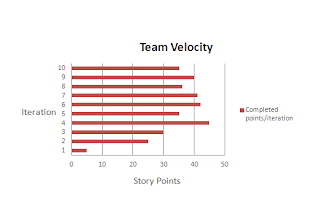This article talks about calculating the
team velocity of the agile project and addressing the benefit of the team
velocity.
Velocity is an extremely simple, powerful method for
accurately measuring the rate at which teams consistently deliver business
value.
It
is a measure of how much product backlog items the team can complete in the given
amount of time.
It
is used the compare the iterations for the given team on a given project, the note
is only completed work counts for calculating the velocity.
For
example the testing planned with the in the sprint and one of the story failed
in testing and required more effort to fix all the issues, which goes beyond the
sprint. This story will be dropped from this sprint/iteration. This story will
not be counted for the calculating velocity.
Some of the benefits
of velocities are:
·
Understanding about
agile project performance
·
Reporting project
progress, productivity, predictability
·
Finding pain points
and improvement areas
·
Used as metrics
·
Calculating the rate
at which the product moving forward
·
Provides vision what
can be achieved in next release
The team velocity is calculated based on the completed
story point. I will write another article
to explain the story point estimation.
In simple terms, a story point is a measure of complexity.
This is to differentiate it with hourly estimates, which are a measure of effort.
The
second idea is that story points are a relative measure. That means we choose one user story
and keep it as the reference and assign it a value of 1 point. We then measure
every other story relative to this one. So if the second story is twice as
complex, we give it a value of 2 points. Thrice as complex and it gets 3 points
and so on. Go through the entire backlog this way.
The story point can be mapped to the effort, for example to complete development of 1 point takes 4 hrs. This is used as the reference, but the effort will vary the person who implements it.
Velocity is a vital component of iterative planning. To see how it is used, consider this example:
1)
A team reviews a
release backlog with the product owner, and estimates the relative sizes of
user stories in units of story points (one story might be sized at 3 points,
another at 1 point, etc.). The release backlog, when estimated, totals 120
story points.
2)
Over the course of several iterations, that
same team has demonstrated that it consistently delivers between 18 and 22
story points per 2-week iteration, to an agreed definition of “done”. It
therefore considers its velocity to be approximately 20 points per 2-week
iteration for planning purposes.
3)
Based on a total
backlog size of 120 points, and a velocity of 20 points per 2-week iteration,
it can be determined that it will take this team 120 divided by 20, or a total
of six 2-week iterations (12 weeks)
to deliver the entire backlog.
4)
If the product
owner has a hard delivery date commitment that will only allow 8 weeks for the
release, then they will only have four
2-week iterations to work with, and will have to decide which 80 story
points worth of stories ([8 weeks /2 weeks = 4 iterations] * 20 story points
per iteration) are the most important.
So in the case above, size
is estimated, velocity is measured, and duration is derived.
The below velocity graph shows the team velocity
of the given project, when we look in to the story point completed per iteration
is not stable, as mentioned above we need to make the necessary improvement actions
this will help the team to stabilize the project in 3 to 6 iterations.
The Control Chart below shows the iteration velocity that tracks the
story point’s completion per iteration. It is the good indicator of
productivity throughput and the tolerances can be used for the investigation,
if it drops below the lower limit.
Based on the historical
data of the project the UCL, LCL and the Mean value are calculated. This is
used for the finding the improvement areas.
Kindly note that keep on increasing
the team velocity is not mean to maximize the productivity, when we focus more
on increasing the team velocity the team may skip following standards, unit
testing, bug-fixing. The goal is to maintain
the optimum velocity over time, which takes account of following standards,
quality and other factors.



Nice article and you have provided usefull information.
ReplyDeleteWish you good luck for your blog.
It is a known fact that ILLUMINATI consist of Multi Millionaires,Billionaires who have major influence regarding global affairs, and planning of a New world order. Many world leaders, Presidents, prime ministers, royalty and senior executives are members of ILLUMINATI. follow the steps to Excel in Life. you'll have numerous benefits,for the FIRST TIME IN HISTORY, we are opening our doors to those who believe. If you would like to join ILLUMINATI , to sign up Text: leovincey08@gmail.com or whatsapp +2349033667873 now if you are really serious to help your self
ReplyDeletekuşadası
ReplyDeletesakarya
sinop
bolu
burdur
PNNJ